Where we lived : discovering the places we once called home, the american home from 1775 to 1840
$54.00
(disponible sur commande)
Résumé:
What was life like when a dozen people lived in a house not much bigger than a modern garage ? When children were born at home, people were maried at home and, later, died, were laid out, mourned, and buried at home ? This book is about how early American families lived in these old houses and the range of their lives in them - from the impossibly wealthy to the(...)
Where we lived : discovering the places we once called home, the american home from 1775 to 1840
Actions:
Prix:
$54.00
(disponible sur commande)
Résumé:
What was life like when a dozen people lived in a house not much bigger than a modern garage ? When children were born at home, people were maried at home and, later, died, were laid out, mourned, and buried at home ? This book is about how early American families lived in these old houses and the range of their lives in them - from the impossibly wealthy to the unimaginably poor, from Boston and New York to the small farms and plantations of the rural South, from trim New England villages to the raw frontier "West" of Missouri, Ohio, and Illinois. Here is a look to date of how families lived at the dawn of the republic and how their houses shaped their lives.
Histoire jusqu’à 1900
$37.50
(disponible sur commande)
Résumé:
Toward the end of the sixteenth century, and throughout the seventeenth, thinking in spatial terms assumed extraordinary urgency among Russia's ruling elites. The two great developments of this era in Russian history - the enserfment of the peasantry and the conquest of a vast Eastern empire-fundamentally concerned spatial control and concepts of movements across the(...)
Cartographies of tsardom : the land and its meaning in seventeenth-century Russia
Actions:
Prix:
$37.50
(disponible sur commande)
Résumé:
Toward the end of the sixteenth century, and throughout the seventeenth, thinking in spatial terms assumed extraordinary urgency among Russia's ruling elites. The two great developments of this era in Russian history - the enserfment of the peasantry and the conquest of a vast Eastern empire-fundamentally concerned spatial control and concepts of movements across the land. In "Cartographies of tsardom", Valerie Kivelson explores how these twin themes of fixity and mobility obliged Russians, from tsar to peasant, to think in spatial terms. She builds her case through close study of two very different kinds of maps: the hundreds of local maps hand-drawn by amateurs as evidence in property litigations, and the maps of the new territories that stretched from the Urals to the Pacific. In both the simple maps that local residents drafted and in the more formal maps of the newly conquered Siberian spaces, Kivelson shows that the Russians saw the land (be it a peasant's plot or the Siberian taiga) as marked by the grace of divine providence. She argues that the unceasing tension between fixity and mobility led to the emergence in Eurasia of an empire quite different from that in North America. In her words, the Russian empire that took shape in the decades before Peter the Great proclaimed its existence was a “spacious mantle,” a “patchwork quilt of difference under a single tsar” that granted religious and cultural space to non-Russian, non-Orthodox populations even as it strove to tie them down to serve its own growing fiscal needs. The unresolved, perhaps unresolvable, tension between these contrary impulses was both the strength and the weakness of empire in Russia.
Histoire jusqu’à 1900
$25.95
(disponible sur commande)
Résumé:
This superb guide at last brings the work of Filippo Coarelli, one of the most widely published and best known scholars of Roman archeology and art, to a wide, English-language audience. Conveniently organized by walking tours and illustrated throughout with clear maps, drawings, and plans, Rome and Environs: An Archaeological Guide covers all of the city's ancient sites,(...)
Rome and environs: an archaeological guide
Actions:
Prix:
$25.95
(disponible sur commande)
Résumé:
This superb guide at last brings the work of Filippo Coarelli, one of the most widely published and best known scholars of Roman archeology and art, to a wide, English-language audience. Conveniently organized by walking tours and illustrated throughout with clear maps, drawings, and plans, Rome and Environs: An Archaeological Guide covers all of the city's ancient sites, and, unlike most other guides, now includes the major monuments in a large area outside Rome proper but within easy reach, such as Ostia Antica, Palestrina, Tivoli, and the many areas of interest along the ancient Roman roads. An essential resource for tourists interested in a deeper understanding of Rome's classical remains, it is also the ideal book for students and scholars approaching the ancient history of one of the world's most fascinating cities. Covers all the major sites including the Capitoline, the Roman Forum and the Imperial Fora, the Palatine Hill, the Valley of the Colosseum, the Esquiline, the Caelian, the Quirinal, and the Campus Martius. Two separate chapters discuss important clusters of sites-one on the area surrounding Circus Maximus and the other in the vicinity of the Trastevere, including the Aventine and the Vatican. Additional chapters cover the city walls and the aqueducts. Features 189 maps, drawings, and diagrams; an appendix on building materials and techniques; and an extensive bibliography.
Histoire jusqu’à 1900
Rome from the ground up
$42.95
(disponible sur commande)
Résumé:
James H.S. McGregor traces the successive urban forms that rulers have imposed, from emperors and popes to national governments including Mussolini's. In archaeologists' and museums' presentation of Rome's past, he shows that the documenting of history itself is fraught with power and politics. In McGregor's own account, the power and politics emerge clearly, manifest in(...)
Histoire jusqu’à 1900
octobre 2006, Cambridge, Mass.
Rome from the ground up
Actions:
Prix:
$42.95
(disponible sur commande)
Résumé:
James H.S. McGregor traces the successive urban forms that rulers have imposed, from emperors and popes to national governments including Mussolini's. In archaeologists' and museums' presentation of Rome's past, he shows that the documenting of history itself is fraught with power and politics. In McGregor's own account, the power and politics emerge clearly, manifest in the distinctive styles and structures, practical concerns and aesthetic interests that constitute the myriad Romes of our day and days past.
Histoire jusqu’à 1900
A day in a Medieval city
$22.50
(disponible sur commande)
Résumé:
An opportunity to experience the daily hustle and bustle of life in the late Middle Ages, "A Day in a Medieval City" provides a dawn-to-dark account of medieval life. A visual trek through the thirteenth and fourteenth centuries - with seasoned historian and expert on medieval iconography Chiara Frugoni as guide - this book offers a vast array of images and vignettes that(...)
A day in a Medieval city
Actions:
Prix:
$22.50
(disponible sur commande)
Résumé:
An opportunity to experience the daily hustle and bustle of life in the late Middle Ages, "A Day in a Medieval City" provides a dawn-to-dark account of medieval life. A visual trek through the thirteenth and fourteenth centuries - with seasoned historian and expert on medieval iconography Chiara Frugoni as guide - this book offers a vast array of images and vignettes that depicts the everyday hardships and commonplace pleasures for people living in the Middle Ages. "A Day in a Medieval City" breathes life into the activities of the city streets, homes, fields, schools, and places of worship. With entertaining anecdotes and gritty details, it engages the modern reader with its discoveries of the religious, economic, and institutional practices of the day. From urban planning and education to child care, hygiene, and the more leisurely pursuits of games, food, books, and superstitions, Frugoni unearths the daily routines of the private and public lives of citizens.
Histoire jusqu’à 1900
$50.00
(disponible sur commande)
Résumé:
Linda Seidel has now expertly transcribed and edited Meyer Schapiro's 1967 lectures, presenting them for the first time to an audience beyond the halls of Harvard.
Histoire jusqu’à 1900
novembre 2006, Chacago / London
Romanesque architectural sculpture, the Charles Eliot Norton Lectures
Actions:
Prix:
$50.00
(disponible sur commande)
Résumé:
Linda Seidel has now expertly transcribed and edited Meyer Schapiro's 1967 lectures, presenting them for the first time to an audience beyond the halls of Harvard.
Histoire jusqu’à 1900
$79.00
(disponible sur commande)
Résumé:
Long Island’s North Fork is a pastoral quilt of vineyards and farms by the sea. To the north are the sandy beaches of Long Island Sound and to the south a collection of harbors and fishing villages overlooking Peconic Bay. Stretching out some thirty miles from the mainland, this narrow peninsula is a place of serenity and beauty. Photographer Jake Rajs has captured(...)
Between sea and sky : landscapes of Long Island's North Fort
Actions:
Prix:
$79.00
(disponible sur commande)
Résumé:
Long Island’s North Fork is a pastoral quilt of vineyards and farms by the sea. To the north are the sandy beaches of Long Island Sound and to the south a collection of harbors and fishing villages overlooking Peconic Bay. Stretching out some thirty miles from the mainland, this narrow peninsula is a place of serenity and beauty. Photographer Jake Rajs has captured the spirit of the North Fork - the glorious colors of sunrise and sunset, the calm waters, and the vast expanses of fields and wetlands. He focuses on architectural landmarks as well - the Victorian houses on Shelter Island, eighteenth-century barns, the Orient Point Lighthouse - to create a complete portrait of this unspoiled land. Complementing the visual presentation is an essay by Jesse Browner that evokes the spirit of the North Fork and its people, tracing the evolution of the land from colonial farms to the vineyards that have emerged over the past thirty years.
Histoire jusqu’à 1900
$78.00
(disponible sur commande)
Résumé:
Focusing on the methodology of preservation technology, this book tells the story of the $90 million historic preservation of a designated New York City landmark. It presents the restoration and adaptive reuse of the magnificent courthouse, built by New York's crooked 'Boss' Tweed, as an exemplar of preservation practice. The project is unique, but the approach and(...)
Histoire jusqu’à 1900
juillet 2006, New York
Tweed courthouse: a model restoration
Actions:
Prix:
$78.00
(disponible sur commande)
Résumé:
Focusing on the methodology of preservation technology, this book tells the story of the $90 million historic preservation of a designated New York City landmark. It presents the restoration and adaptive reuse of the magnificent courthouse, built by New York's crooked 'Boss' Tweed, as an exemplar of preservation practice. The project is unique, but the approach and techniques utilized in the work have application for saving other public buildings.
Histoire jusqu’à 1900
$55.00
(disponible sur commande)
Résumé:
A phenomenon as old as humanity, megalomania has become, now more than ever, an attitude reflective of our contemporary culture. It reveals a universal desire: to be noticed and unique, political and dangerous. In this book, Philippe Tretiack casts his humorous and scathing eye over a gallery of megalomaniacs who push the envelope, paying alarmed homage to these high(...)
Megalomania, too much is never enough
Actions:
Prix:
$55.00
(disponible sur commande)
Résumé:
A phenomenon as old as humanity, megalomania has become, now more than ever, an attitude reflective of our contemporary culture. It reveals a universal desire: to be noticed and unique, political and dangerous. In this book, Philippe Tretiack casts his humorous and scathing eye over a gallery of megalomaniacs who push the envelope, paying alarmed homage to these high priests of excess and their dazzling displays of eccentricity. From power-grasping leaders to rappers bedecked in bling, from showbiz stars to bloodthirsty war chiefs to decadent dandies, Megalomania shakes up the artists of this new nihilism, in which materialism flirts with mortality. Megalomania: extravagance as a dare.
Histoire jusqu’à 1900
$65.00
(disponible sur commande)
Résumé:
In this book on the American Queen Anne style, Janet W. Foster presents a recognition of these houses' place in the history of American architecture. Built across the U.S. during the late 19th century (The Inn at Castle Hill in Newport, RI, is a popular example), features of Queen Anne homes include gabled roofs; corbelled chimneys; vertical windows; large porches;(...)
The Queen Anne house : America's victorian vernacular
Actions:
Prix:
$65.00
(disponible sur commande)
Résumé:
In this book on the American Queen Anne style, Janet W. Foster presents a recognition of these houses' place in the history of American architecture. Built across the U.S. during the late 19th century (The Inn at Castle Hill in Newport, RI, is a popular example), features of Queen Anne homes include gabled roofs; corbelled chimneys; vertical windows; large porches; balconies; and cut-stone foundations. Foster explains distinguishing elements of the Queen Anne tradition as she examines 21 noted homes, many of them not open to the public and never before published. With more than 200 magnificent photographs by Radek Kurzaj.
Histoire jusqu’à 1900









